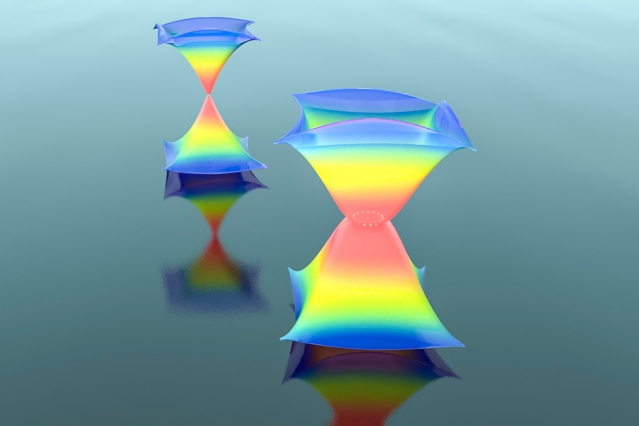The Dirac cone, named after British physicist Paul Dirac, started as a concept in particle and high-energy physics and has recently became important in research in condensed matter physics and material science. It describes aspects of graphene, a two dimensional form of carbon, suggesting the possibility of applications across various fields.
Now physicists at MIT have found another unusual phenomenon produced by the Dirac cone: It can spawn a phenomenon described as a “ring of exceptional points.” This connects two fields of research in physics and may have applications in building powerful lasers, precise optical sensors, and other devices.
This work represents the first experimental demonstration of a ring of exceptional points, and is the first study that relates research in exceptional points with the physical concepts of parity-time symmetry and Dirac cones.

A schematic drawing of how a ring of exceptional points can be spawned from a Dirac point (a dot), and thus change the dispersion from the normal, widely known conical shape into an exotic lantern-like shape
Individual exceptional points are a peculiar phenomenon unique to an unusual class of physical systems that can lead to counter-intuitive phenomena. For example, around these points, opaque materials may seem more transparent, and light may be transmitted only in one direction. However, the practical usefulness of these properties is limited by absorption loss introduced in the materials.
The MIT team used a nanoengineered material called a photonic crystal to produce the exceptional ring. This new ring of exceptional points is different from those studied by other groups, making it potentially more practical, the researchers say. The researchers adopted a different loss mechanism — radiation loss — which does not affect the device performance. This radiation loss is useful and necessary in devices like lasers.
This phenomenon could enable creation of new kinds of optical systems with novel features, the MIT team says. It could lead to a more powerful laser system than existing technologies allow. To build a more powerful laser requires a bigger lasing area, but that introduces more unwanted modes for light, which compete for power, limiting the final output. Photonic crystal surface-emitting lasers are very promising for next generation high-quality, high-power compact laser systems, and the researchers think they can improve the output power limit of such lasers by a factor of at least 10. It could also be used for high-precision detectors for biological or chemical materials, because of its extreme sensitivity. For more information: http://news.mit.edu/
Advertisement





